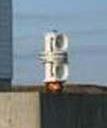The automation of fixed aids to navigation has had its effect on the fog signals sited at major lighthouses.
Inside the horn assembly is a steel plate that acts as a movable diaphragm.
Affixed to the back of the plate is a magnet and encircling the magnet is a coil of wire.
When current flows through the coil, a magnetic field is produced.
This field attracts the magnet, drawing it into the coil and warping the steel plate.
Because this is AC, the current suddenly changes direction, causing the magnetic field around the coil to collapse.
Freed from the attraction of the magnetic field, the steel plate releases the energy it has stored by its initial
warping and outward. Current now flows in the opposite direction, establishing a second magnetic field around the coil.
Once again, the magnet is drawn into the coil, warping the steel plate.
With another reversal of current, the magnetic field collapses and the plate releases energy, springing away from the coil.
So, the steel diaphragm goes through two vibrations per cycle, thus, it vibrates at an acoustical frequency of 300 Hz.
Electronic Fog Signals can be identified by their sound code, for example, Cape Race Horn is: blast 3 seconds,
silent 3 seconds, blast 3 seconds then silent for 51 seconds.

|



